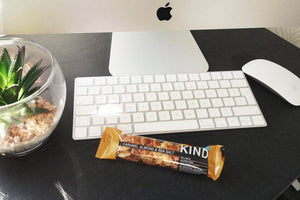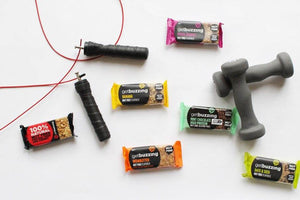Alright, buckle up buttercups, because we're diving headfirst into the wonderful world of protein! Forget boring definitions and dry facts, we're going on a protein adventure!
If you want to digest this via our podcast, click play below:
High Protein Foods: What's the Fuss
Protein, it's not just for gym buffs, you know! This mighty macronutrient is the unsung hero of our bodies, keeping everything from our muscles to our metabolism ticking over nicely. Think of it as the building blocks for a super-powered you! You're curious about what makes a food a protein powerhouse in the UK, where to find these glorious sources, and how food wizards whip up extra protein into our favourite snacks? Well, grab a cuppa, because we're about to spill the beans (and maybe some whey!).
Decoding the Protein Puzzle: What Counts as "High Protein" Here?
Right, let's get down to brass tacks. In the UK, a food gets the "high protein" badge if at least 20% of its total energy comes from protein. Think of it like this: protein needs to be a major player in the food's nutritional line-up, not just a bit-part actor. Now, if a food has protein making up at least 12% of its energy, it's considered a "source of protein" - a decent contributor, but not quite a superstar. It's also worth noting that while we're talking about individual foods here, some folks reckon a diet is "high protein" if more than 15% of your daily energy comes from the stuff. So, it's all about context, innit?
Nature's Protein Gems: Where to Find the Good Stuff
Mother Nature's been busy whipping up some seriously protein-packed goodies, and they come in all shapes and sizes!
Animal All-Stars:
- Meat & Poultry: Think juicy chicken breasts (around 32g of protein per 100g - that's a lot!), lean pork loin (about 31.6g), and a good ol' steak (around 31g). Turkey's another winner (about 26g), and even goose has a decent showing (around 22.8g). Remember, leaner cuts and ditching the skin are your mates here for bumping up the protein punch.
- Fish & Seafood: Dive into the protein-rich ocean! Tuna's a top catch (around 26.8g), salmon's swimming in it (21.2-25g depending on the type), and cod's a solid choice (around 23.9g). Mackerel (around 20.3g), haddock (around 17.9g), and even crab (around 18.1g), mussels (around 17.7g), and prawns (around 15.4g) are all on the menu. Oily fish like salmon and mackerel are also packed with those brain-boosting omega-3s - bonus!
- Eggs: The humble egg is a protein powerhouse! We're talking 12.3-14.1g per 100g, and a medium egg clocks in at around 7g. Plus, they're a "complete" protein, meaning they've got all the essential amino acids. Cracking!
- Dairy Delights: From Parmesan (a whopping 33.6g!) to cheddar (25.4-25.8g), dairy can be a protein goldmine. Even reduced-fat cheddar can pack a punch (around 27.9g). Cottage cheese (9.4-12g), Greek yogurt (5.7-10g), skyr (around 11g), and milk (3.4-3.5g) are also great options. Go for lower-fat versions to keep things healthy without skimping on the protein.
Plant-Powered Protein Heroes:
- Legumes: Think lentils (7.6-8.8g when boiled), chickpeas (7.2-7.6g canned), and kidney beans (6.1-8.7g canned). Black beans (around 8.9g) and edamame (10.7-12g) are also fantastic. Legumes are not just protein-packed, they're also bursting with fibre and other goodies.
- Soy Superstars: Tofu (8-8.1g), tempeh (around 19g), soy milk (3.2-6g per 200ml), and soy yogurt (around 5g per 125ml) are all excellent plant-based protein sources. They're also "complete" proteins, making them a winner for vegans and vegetarians.
- Nuts & Seeds: Almonds (around 21.1g), peanuts (around 26g), pumpkin seeds (around 7g per 30g), sunflower seeds (around 6g per 30g), chia seeds (around 17g), and walnuts (around 4g per 30g) are all great sources of protein, healthy fats, and fibre. Just watch those portion sizes, as they can be calorie-dense.
- Grains with Gains: Cooked quinoa (4-8g per 185g), oats (around 4g per 40g), brown rice (around 7g per 185g), and brown bread (around 7.9g per 100g) all contribute to your protein intake. Opt for whole grains for extra fibre and nutrients.
- Veggie Vibes: Even some veggies pack a protein punch! Bean sprouts (around 10g), lentil sprouts (around 9g), baby spinach (2.5g - surprisingly high in protein energy!), broccoli (around 3.6g), and spinach (around 2.6g) can all contribute to your daily protein needs.

Table 1: Protein Powerhouses in a Nutshell (per 100g)
| Food Category | Food Item | Protein Content (g) |
|---|---|---|
| Meat | Chicken Breast | 32 |
| Meat | Lean Pork Loin | 31.6 |
| Meat | Lean Beef Steak | 31 |
| Fish | Tuna | 26.8 |
| Fish | Salmon | 21.2-25.0 |
| Eggs | Whole Egg | 12.3-14.1 |
| Dairy | Parmesan Cheese | 33.6 |
| Dairy | Cheddar Cheese | 25.4-25.8 |
| Legumes | Lentils (boiled) | 7.6-8.8 |
| Legumes | Chickpeas (canned) | 7.2-7.6 |
| Soy Products | Tofu | 8.0-8.1 |
| Soy Products | Tempeh | 19 |
| Nuts/Seeds | Almonds | 21.1 |
| Nuts/Seeds | Peanuts | 26 |
| Grains | Quinoa (cooked) | 4.0-8.0 |
| Vegetables | Bean Sprouts | 10 |
Supercharging Our Grub: How Protein Gets Added to Foods
Food companies are like protein wizards, using various ingredients to boost the protein content of our food.
Common Protein Add-Ins:
- Whey Protein: This is a byproduct of cheese making, and it comes in different forms like whey protein concentrate (WPC), isolate (WPI), and hydrolysate (WPH). WPI is super high in protein (over 90%) and gets absorbed quickly, making it popular for muscle recovery.
- Soy Protein: Derived from soybeans, it comes in forms like soy flour, concentrate, and isolate. Soy protein isolate is highly refined, has a neutral taste, and is used in everything from meat alternatives to protein fortification.
- Pea Protein: Made from yellow split peas, it's a popular plant-based, allergen-free option. Pea protein isolate can have over 80% protein and is used in vegan products and protein supplements.
- Other Plant Proteins: Rice protein, hemp protein, mycoprotein (Quorn), and fava bean protein are also used to add protein to foods, catering to different dietary needs and preferences.
Protein Fortification in Action:
These protein ingredients get mixed into all sorts of things! Think protein powders for shakes, protein bars, and even everyday foods like breakfast cereals, yogurts, milk alternatives, and pasta. They're also key in making plant-based meat and dairy alternatives. You can even boost your own meals by adding things like dried milk powder, ground almonds, or grated cheese.
Why the Protein Push?
There are loads of reasons why food companies add extra protein. It helps meet the needs of athletes, older adults, and people with certain health conditions. Protein can also help you feel full, which is great for weight management. Plus, it's essential for muscle growth and repair, making protein-fortified products popular with gym-goers. Convenience is also a big factor, as protein-packed snacks and drinks are an easy way to boost your intake. And let's not forget the growing demand for high-protein and plant-based options!
Table 2: Protein Power-Ups in Our Food
| Protein Ingredient | Source | Typical Protein Content (%) | Common Applications in Food Products |
|---|---|---|---|
| Whey Protein Isolate | Milk | > 90 | Protein powders, bars, shakes, fortified foods |
| Soy Protein Isolate | Soybeans | > 90 | Meat alternatives, dairy alternatives, protein powders, fortified foods |
| Pea Protein Isolate | Yellow Peas | > 80 | Plant-based meats, dairy alternatives, protein powders, snacks |
| Whey Protein Concentrate | Milk | 30-89 | Protein powders, bars, fortified foods |
| Soy Protein Concentrate | Soybeans | ~ 70 | Baked goods, breakfast cereals, meat products |
| Pea Protein Concentrate | Yellow Peas | < 80 | Various food and beverage applications |
Protein Pointers: What's Recommended?
In the UK, the recommended protein intake for adults is 0.75 grams per kilogram of body weight per day. So, if you weigh 60kg, you'd need about 45 grams of protein a day. Interestingly, most people in the UK already eat more than this! However, certain groups like athletes, older adults, and pregnant or breastfeeding women might need more. The UK guidelines encourage getting protein from a variety of sources, especially plant-based options like beans, lentils, and peas, which are not only packed with protein but also low in fat and high in fibre.
The Protein Lowdown: A Fun Recap!
So, there you have it! A "high protein" food in the UK is one where at least 20% of its energy comes from protein. There's a whole world of naturally high-protein foods out there, both from animals and plants. And the food industry is getting clever with adding protein to our favourite products. While most of us in the UK get enough protein, understanding the definitions and how it's added can help us make informed choices for our health and fitness goals. Now, go forth and enjoy those protein-packed delights!
Top 10 Tips for Getting Enough Protein in Your Diet:
- Start Your Day with Protein Power: Don't skip breakfast! Opt for eggs, Greek yogurt, or even a protein smoothie to kickstart your protein intake early.
- Snack Smart with Protein: Ditch the sugary treats and reach for protein-rich snacks like nuts, seeds, hard-boiled eggs, or a small pot of cottage cheese.
- Lean into Lean Meats: Choose leaner cuts of meat like chicken breast, turkey, and lean beef. They're packed with protein without the excess fat.
- Fish is Your Friend: Aim for at least two portions of fish a week, including oily fish like salmon and mackerel, which are not only high in protein but also great for your heart.
- Embrace Plant-Based Protein: Incorporate more plant-based protein sources like lentils, beans, chickpeas, tofu, and tempeh into your meals. They're versatile and packed with other nutrients too.
- Don't Forget the Dairy: Milk, yogurt, and cheese are all good sources of protein. Opt for lower-fat versions if you're watching your intake.
- Sprinkle on the Seeds and Nuts: Add a handful of nuts or seeds to your breakfast cereal, salads, or yogurt for a protein boost.
- Protein Powder Power-Up: If you're struggling to meet your protein needs, a scoop of protein powder in a smoothie or shake can be a convenient way to top up.
- Read Those Labels: Keep an eye on the nutritional information on food packaging to identify high-protein options and track your intake.
- Spread Your Protein Throughout the Day: Instead of having one massive protein hit, aim to include protein in each of your meals and snacks to maximise absorption and utilisation by your body.
So there you have it! Getting enough protein doesn't have to be a chore. With a bit of planning and these handy tips, you can ensure you're fuelling your body with the protein it needs to thrive. Cheers to a protein-rich and healthy you!
Top 10 Vegetarian Protein Powerhouses:
For vegetarians looking to pack in the protein, here are 10 fantastic sources, ranked by their approximate protein content per 100g (where data is available):
- Peanuts: Coming in strong with approximately 26 grams of protein per 100 grams, peanuts are a surprisingly mighty source.
- Almonds: These crunchy nuts offer around 21.1 grams of protein per 100 grams, making them a great snack or addition to meals.
- Tempeh: This fermented soybean cake packs a punch with about 19 grams of protein per 100 grams. It's also a fantastic source of probiotics!
- Raw Chia Seeds: These tiny seeds are nutritional powerhouses, boasting around 17 grams of protein per 100 grams. They're also loaded with fibre and omega-3s.
- Edamame Beans: Whether you enjoy them steamed or roasted, these young soybeans offer a good 10.7 to 12 grams of protein per 100 grams.
- Bean Sprouts: These little shoots can add a protein boost with about 10 grams per 100 grams. They're great in salads and stir-fries.
- Lentil Sprouts: Similar to bean sprouts, lentil sprouts provide around 9 grams of protein per 100 grams and add a lovely texture to dishes.
- Black Beans: These versatile beans offer approximately 8.9 grams of protein per 100 grams and are a staple in many vegetarian dishes.
- Tofu: A classic vegetarian protein source, tofu contains between 8 to 8.1 grams of protein per 100 grams and can be used in countless ways.
- Lentils (boiled): These humble pulses provide a solid 7.6 to 8.8 grams of protein per 100 grams when boiled, and are a fantastic base for soups and stews.
Important Note for Vegetarians: While nuts and seeds are great protein sources, they're often eaten in smaller amounts. It's key for vegetarians to combine different plant-based protein sources throughout the day to ensure they're getting all the essential amino acids their bodies need. Think of it like building a complete protein puzzle!
Don't forget that other vegetarian staples like canned chickpeas, kidney beans, soy milk, soy yogurt, pumpkin seeds, sunflower seeds, walnuts, cooked quinoa, oats, brown rice, brown bread, and even some vegetables like baby spinach and broccoli contribute to your overall protein intake. Every little helps!


























